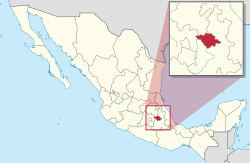Our website is made possible by displaying online advertisements to our visitors.
Please consider supporting us by disabling your ad blocker.
Municipalities of Tlaxcala

Tlaxcala is a state in Central Mexico that is divided into 60 municipalities. According to the 2020 Mexican census, it is the fifth least populated state with 1,342,977 inhabitants and the 2nd smallest by land area spanning 3,996.6 square kilometres (1,543.1 sq mi).[1][2]
Municipalities in Tlaxcala are administratively autonomous of the state according to the 115th article of the 1917 Constitution of Mexico.[3] Every three years, citizens elect a municipal president (Spanish: presidente municipal) by a plurality voting system who heads a concurrently elected municipal council (ayuntamiento) responsible for providing public services for their constituents. The municipal council consists of a variable number of trustees and councillors (regidores y síndicos).[4] Municipalities are responsible for public services (such as water and sewerage), street lighting, public safety, traffic, and the maintenance of public parks, gardens, and cemeteries.[5] They may also assist the state and federal governments in education, emergency fire and medical services, environmental protection, and maintenance of monuments and historical landmarks. Since 1984, they have had the power to collect property taxes and user fees, although more funds are obtained from the state and federal governments than from their own income.[5]
The largest municipality by population is Tlaxcala, with 99,896 residents (7.43% of the state total), while the smallest is San Lucas Tecopilco with 3,077 residents.[1] The largest municipality by land area is Tlaxco which spans 574.70 km2 (221.89 sq mi), and the smallest is San Lorenzo Axocomanitla with 4.50 km2 (1.74 sq mi).[2] In 1995, 16 municipalities were created, the most recent being Benito Juárez, which was established on October 9, 1995.[6]
- ^ a b "Censo de Población y Vivienda 2020–SCITEL" (in Spanish). INEGI. Retrieved 2021-01-27.
- ^ a b "México en cifras–Medio Ambiente–Tlaxcala" (in Spanish). INEGI. Retrieved February 12, 2021.
- ^ Constitución Política de los Estados Unidos Mexicanos (Article 115) (in Spanish). 1917. Retrieved September 27, 2017.
- ^ OECD (November 12, 2004). New Forms of Governance for Economic Development. OECD Publishing. p. 121. ISBN 9789264015326.
- ^ a b Mexico Company Laws and Regulations Handbook. International Business Publications. 2009. p. 42. ISBN 9781433070303.
- ^ Estado de Tlaxcala División Territorial de 1810 a 1995 (PDF) (in Spanish). Mexico: INEGI. 1996. ISBN 9789701314869.
Previous Page Next Page
Liste der Municipios in Tlaxcala German Listo de komunumoj en Tlaxcala EO Anexo:Municipios de Tlaxcala Spanish Liste des municipalités de Tlaxcala French Lijst van gemeenten van Tlaxcala Dutch Liste over kommuner i delstaten Tlaxcala NB Lista gmin w stanie Tlaxcala Polish Муниципалитеты Тласкалы Russian Municipalities o Tlaxcala SCO


